Monkeys live in different parts of the world from Africa to South America and Asia.
Some species are black and white or at least partly black and white. They can be spotted easily since most are arboreal.
Black and white monkeys are generally aggressive, particularly among each other or other monkey species.
Highly intelligent, these are primates that can communicate by vocalizations, often making different sounds to mark their communication objective.
They can also learn to adapt to their habitat better than other animals. For example, some black and white monkeys leverage puddling water as they live in remote areas without any fresh water.
The following species show a combination of both abundant and scarce black and white monkeys with their distinctive physical and behavioral traits.
Some of these monkeys live in large populations while others only survive through tens or hundreds of individuals, often in diminishing habitats.
Table of Contents
1. Mantled Guereza
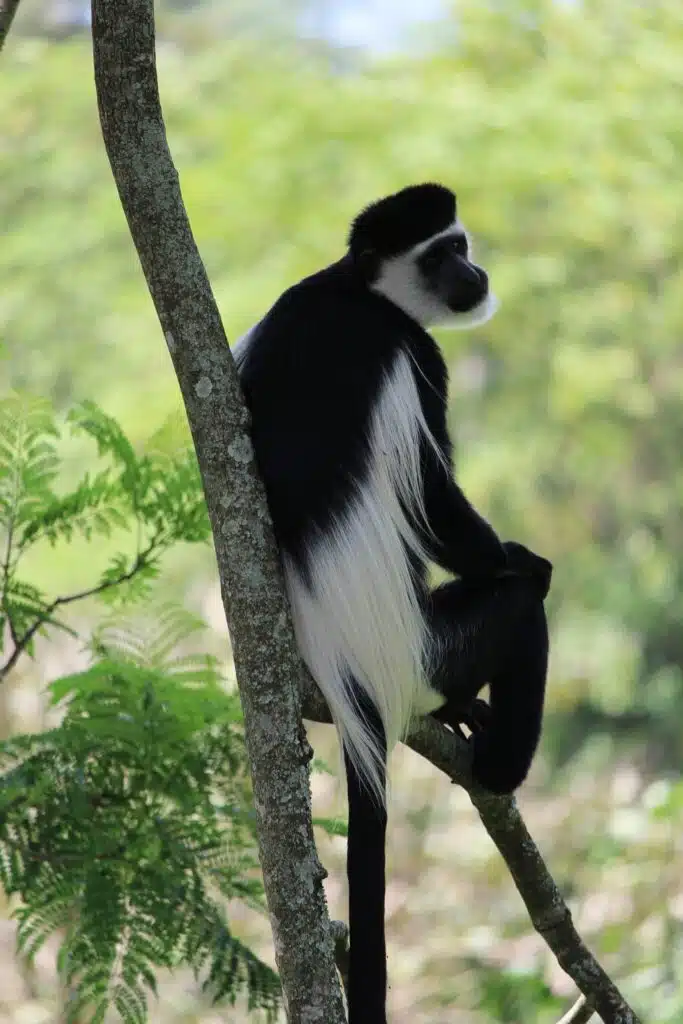
A species of Africa, Mantled Guerezas (Colobus guereza) lives in dense forests, like all other black and white colobuses.
Its white mantle inspires its name. This is a black monkey with long white hair along the back generically referred to as a mantle.
Apart from these white hairs, The Mantled Guereza also shows a white mask and a black head.
The dense forests of Equatorial Africa are its home. While they can be found in wider areas around forests, they are mostly specific to areas close to water, such as lakes.
These types of monkeys spend their days up on trees, where they eat leaves. In addition, they can also eat fruit and the seeds of various species.
Monkeys of this genus are known to live in small groups. They also breed among themselves within a group, with a few exceptions.
Mantled Guerezas are numerous but face a diminishing habitat, hunting habits, and numerous other predators such as Crown hawk eagles.
2. Angola Colobus
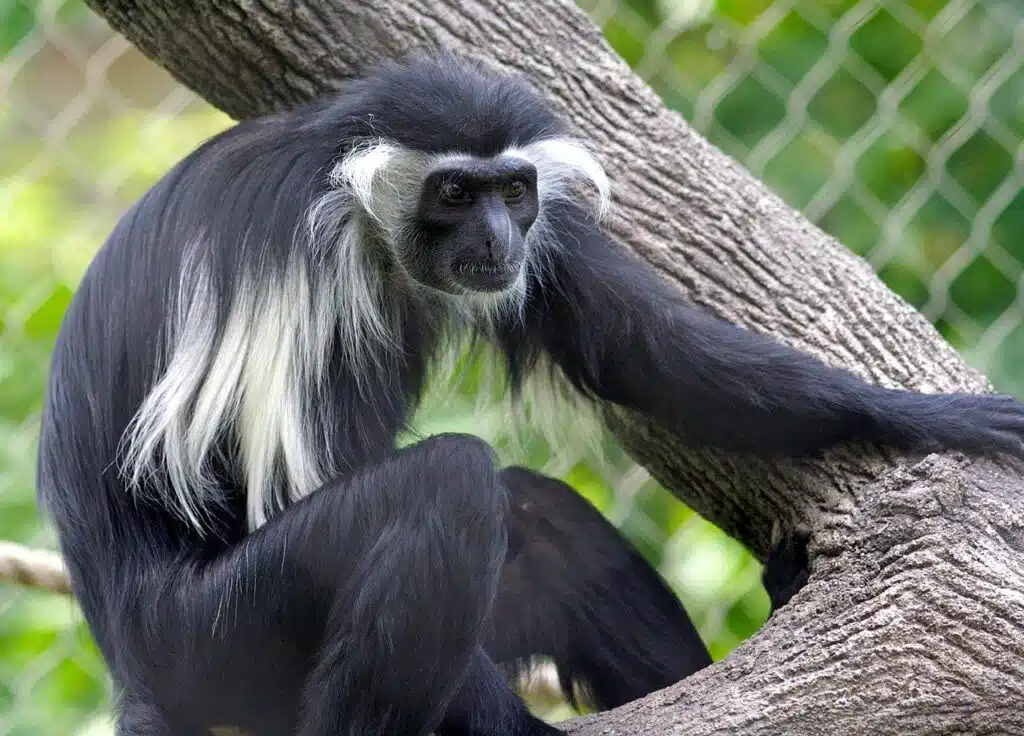
Also a type of black and white colobus, The Angola Colobus (Colobus angolensis) is a species that lives in the African rainforest.
It prefers the forests of The Congo Basin, where it spends its life in groups up on trees. The monkey can live in very large groups where males and females breed with multiple partners.
Mostly black, The Angola Colobus has long white hair around the shoulders and a black and white head.
This is also a species that has long tails which have variable colors. Both black and white tails can be seen on Angola Colobuses.
Highly common in Tanzania, Congo, and other Central African republics, this is a species that is not as common in Angola.
It also lives at very high elevations of several thousand feet in high-density forests.
3. Central American White-Faced Capuchin
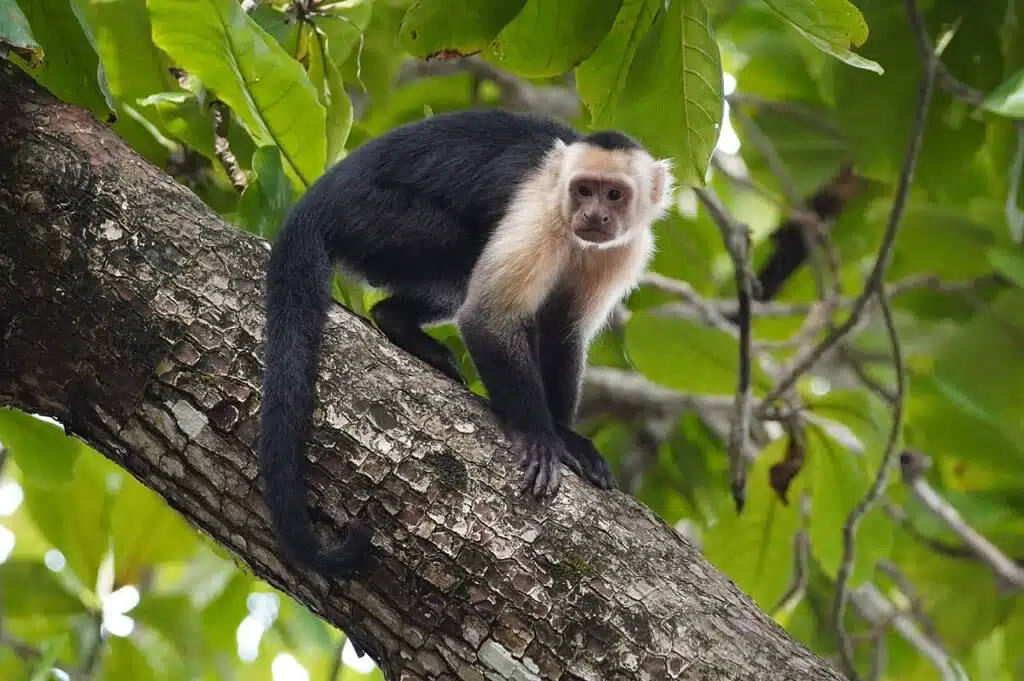
An arboreal monkey of Central America, this (Cebus imitator) is considered an intelligent monkey with unique traits that can be trained as a pet.
It features a mostly black and white body and a pink face.
Found in different types of forests in countries such as Costa Rica, this monkey always lives in small groups.
These groups are always found close to water as the monkey needs water every day, just as humans.
It eats leaves, fruit, as well as a range of other small animals.
These monkeys eat whatever is in season. The rainy season prompts them towards seeds, fruit, and leaves.
The dry season prompts these monkeys to look for other types of food such as small insects.
Its high intelligence has been well-documented. For example, The Central American White-Faced Capuchin is known for its use of plants as potential herbal remedies.
It uses plant leaves to alleviate itching and other minor health concerns.
4. White-Throated Capuchin
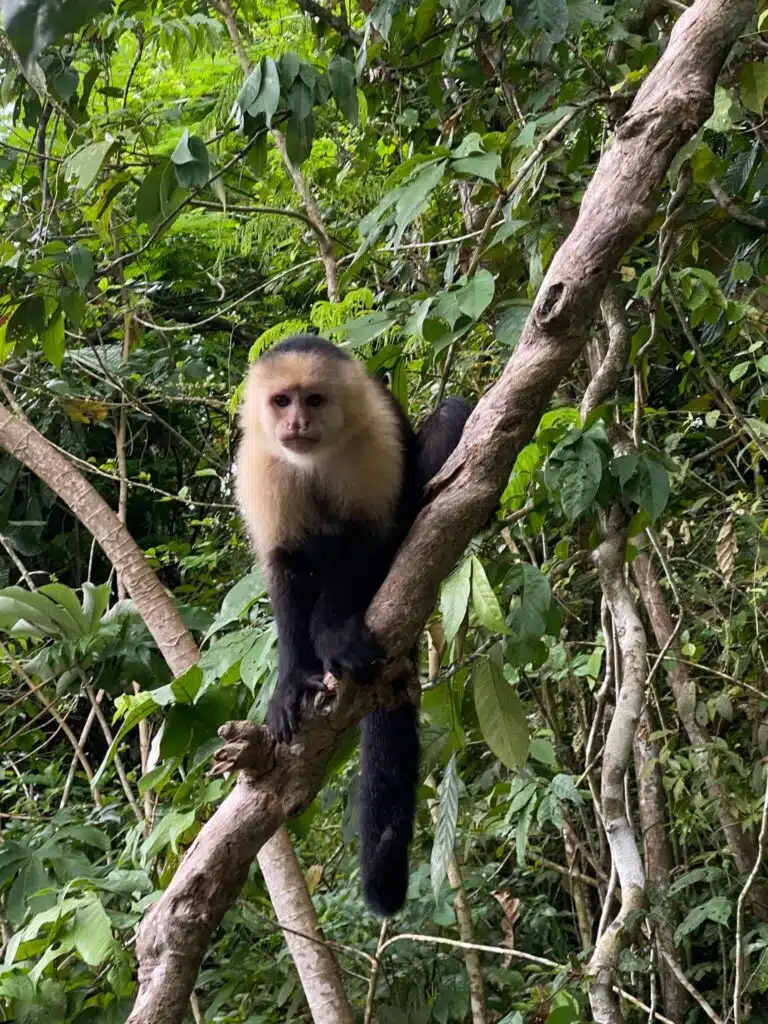
Found in Colombia and on the small Gorgona Island, The White-Throated Capuchin (Cebus capucinus) has black and white hairs.
This is a species with a black and white head and a small stature, growing up to a size of 18 inches.
Found both in wet and dry forests, The White-Throated Capuchin is largely linked to tropical forests.
Such a tropical forest turned into a national park is found on Gorgona Island, a place with many rare species, just off Colombia’s coast.
This is a place where humans are only visitors, where The White-Throated Capuchin thrives.
These types of monkeys live in groups with male and female leaders under certain hierarchies.
Males and females breed among them or with members of other groups.
While small, these monkeys can be aggressive. Particular aggression is noted between groups.
5. L’Hoest’s Monkey
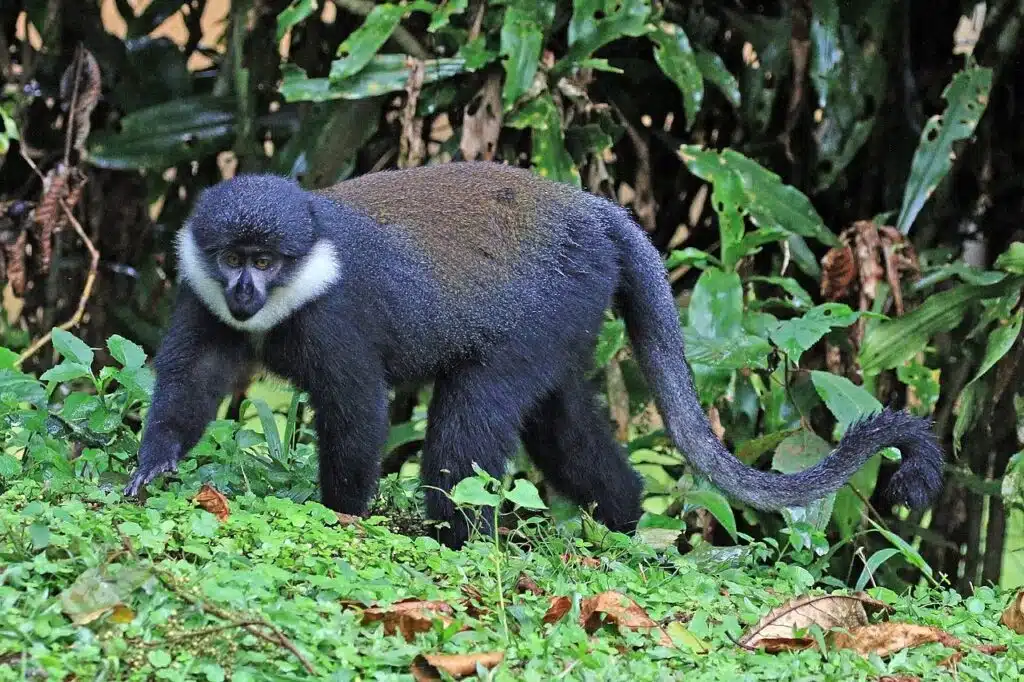
Mostly black and white, L’Hoest’s Monkeys (Allochrocebus lhoesti) can reach a size of up to 27 inches.
The white sections on the monkey are found around the neck, with additional bright sections on the face while most of its body is black.
These types of monkeys are endemic to The Congo Basin where they live in small groups.
Unlike other monkeys such as White-Throated Capuchins which are dominated by alpha males in their social hierarchy, L’Hoest’s Monkeys live in groups dominated by females.
Living on the ground, these monkeys and their groups are mostly female and all-female for most parts of the year.
A single male joins the group for a few weeks, for breeding purposes.
Groups can also be aggressive towards each other and while terrestrial, these monkeys can seek refuge up on trees when threatened.
On the ground, these monkeys feed on plant material such as leaves and roots as well as on fruit.
As omnivores, they can also eat frogs, birds, and bird eggs.
6. Mount Kilimanjaro Guereza
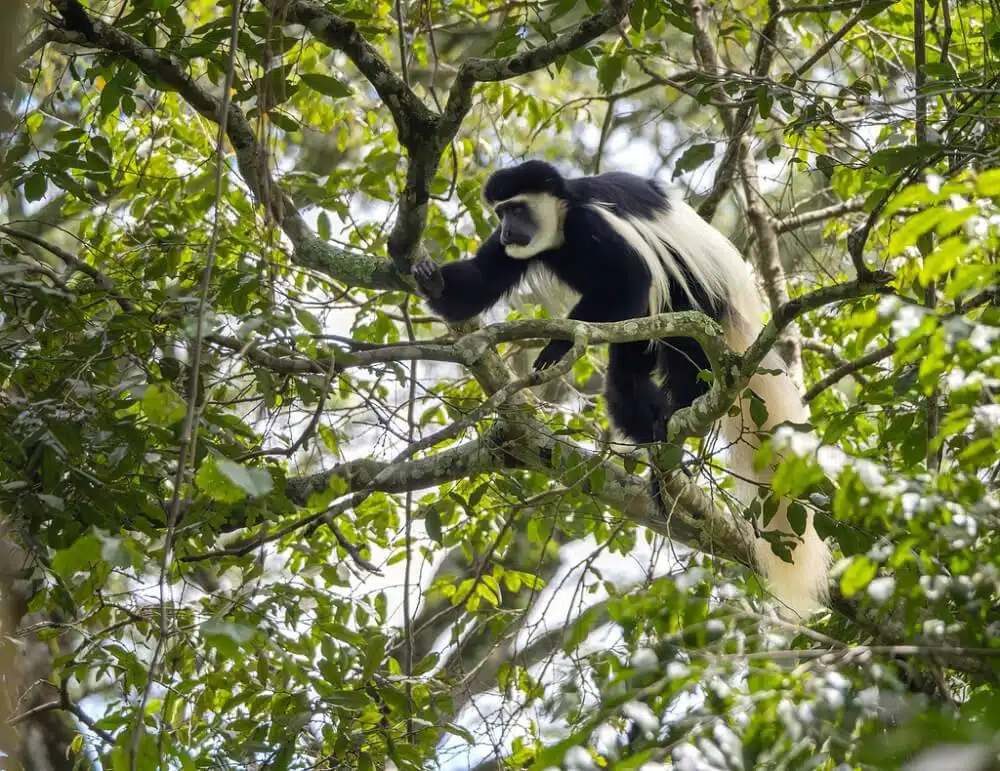
Only recognized as a distinct species a few years ago, The Mount Kilimanjaro Guereza (Colobus caudatus) is a species that has black and white hairs with a white mantle and a common black and white face.
This is also a species with a long white fluffy tail.
This is a species that lives in Central African forests in Tanzania and Kenya.
Unlike other types of guereza monkeys, Mount Kilimanjaro Guerezas are primarily suffering from habitat fragmentation.
This is why they are mostly found in Tanzania.
Like most types of monkeys, this is a species that prefers leaves as the bulk of their diet. Not all leaves are suitable for these monkeys.
Mount Kilimanjaro Guerezas prefers fiber-rich leaves or thicker leaves.
As with other monkeys, they can also eat leaves that would make humans sick as they consume toxic types of leaves.
7. Emperor Tamarin
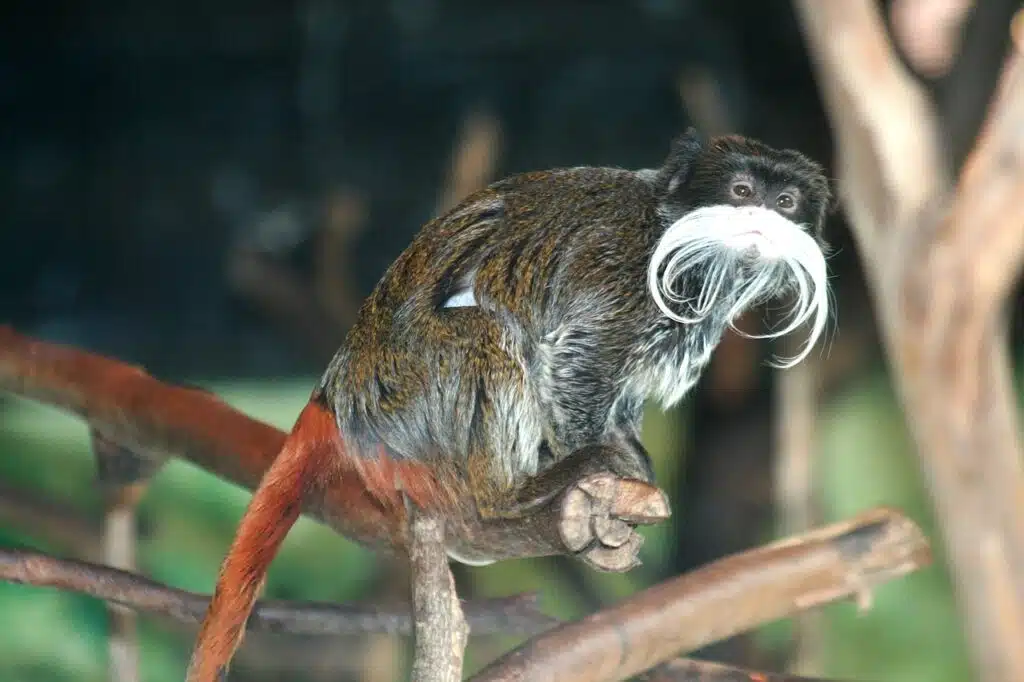
Mostly black, The Emperor Tamarin (Saguinus imperator) is a species with a long white beard and mustache-like white hair.
A species that grows up to 16 inches, this is a monkey endemic to South America. It lives in very humid climates.
Flooded areas of The Western Amazonian Basin are its ideal habitats.
A fast-moving monkey, this is a playful species that feeds under the canopy. It prefers plants, flowers, and fruit.
Emperor Tamarins live in small groups, often dominated by females. The female monkey is also better at finding food.
Even more, this is a species that follows in the footsteps of other monkeys that have superior foraging skills.
Emperor Tamarins share their habitat with Saddle Back Tamarins and follow them for food.
Living in small groups, these monkeys are under the lead of a female who mates with multiple males.
8. Mona Monkey
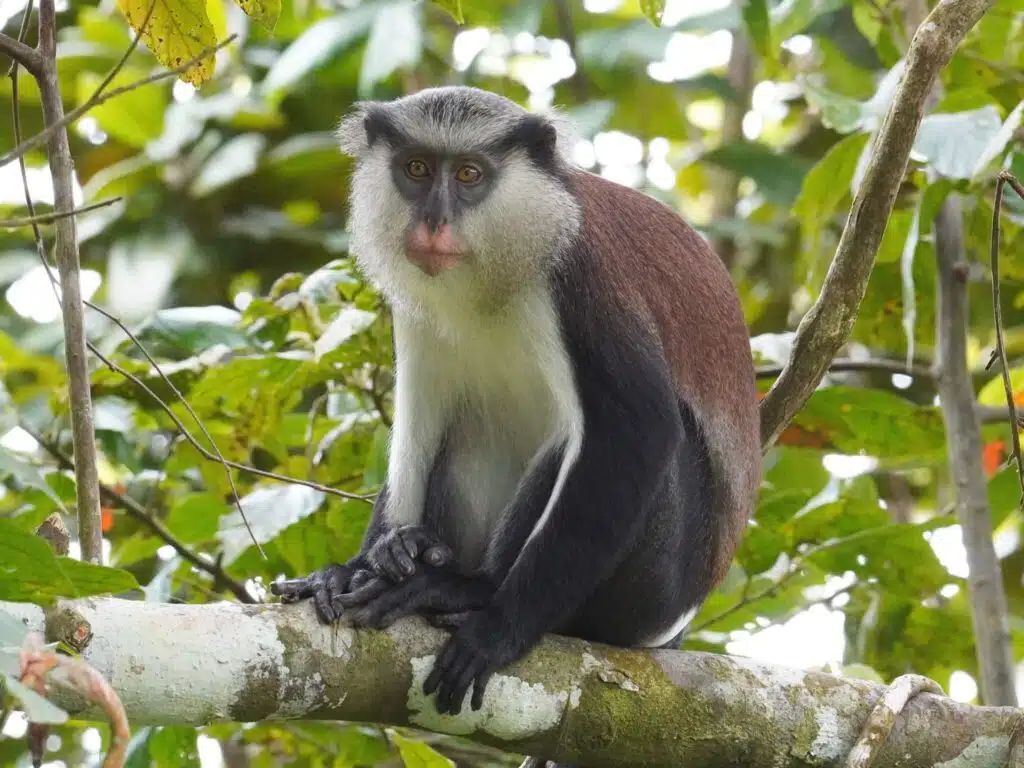
Mona Monkeys (Cercopithecus mona) live in small groups, inhabiting West African forests.
This species is found in Cameroon, Nigeria, and Ghana and has a tricolored appearance.
Its black legs contrast its white face, chest, and front legs while its back is brown.
An arboreal species, The Mona Monkey has yellow hairs on the face while its underside is mostly white.
This is a species that lives in small groups, dominated by females. Only a few monkeys live in a group.
A single male is found in the group, breeding with all related females.
These groups can be large, with tens of female monkeys living with a single male.
This is an adaptable species also introduced in forests in other regions. Mona Monkeys can adapt to disturbed forests well.
They rarely live in forests on their own as they can be spotted with groups of mona monkeys.
9. Lion-Tailed Macaque
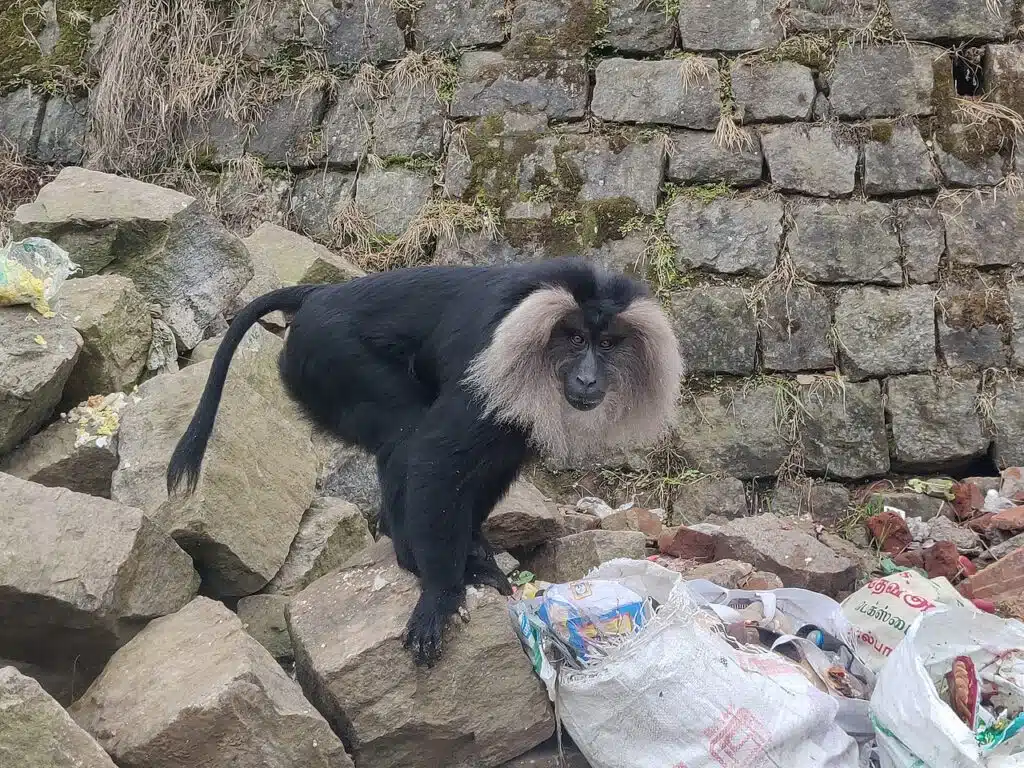
Lion-tailed Macaques (Macaca silenus) are endemic to Southern India. This species appears to be black and white but shows black and off-white or gray hairs.
Mostly black, Lion-Tailed Macaques have a grey mantle around the head. The face is black and without hair.
The nuances of its mane vary from off-white, to gray, or even silver, with age.
Further age-related color variations also include the color of the face which goes from bright to black as the monkeys mature.
Living in small groups, Lion-Tailed Macaques are social. Some groups only have one male. Even larger groups still mostly have 3 males.
These types of monkeys are active and breed throughout the year. They feed on fruit, seeds, and flowers with occasional invertebrates also part of their diet.
Since seeds are an important element of their diet, they play a positive role in the ecosystem by spreading seeds locally.
They do this through feces even if they’re largely omnivorous.
10. Lowe’s Monkey
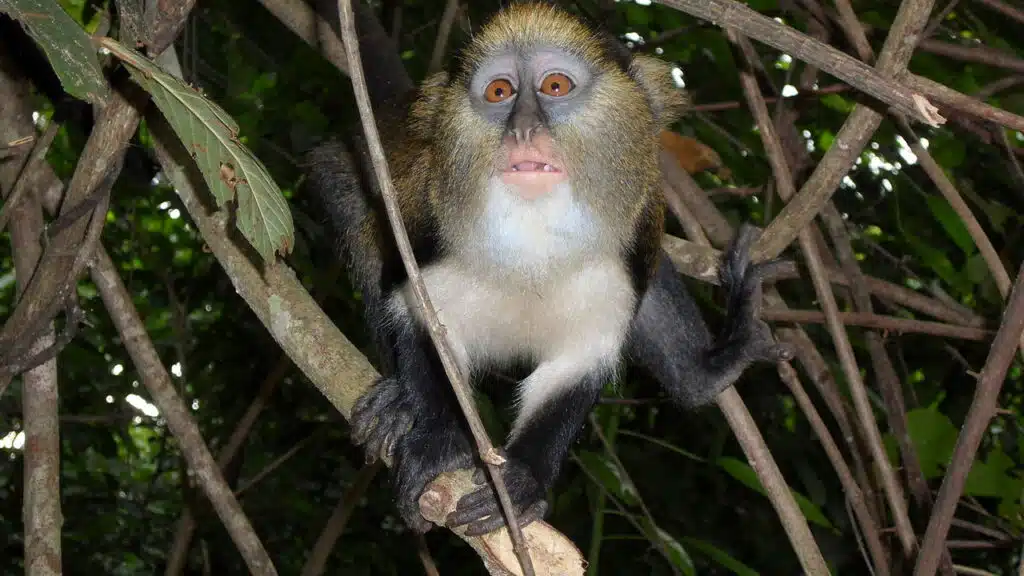
Also known as Lowe’s Mona Monkeys (Cercopithecus lowei), these types of black and white monkeys live in Africa.
A good part of their range expands through protected areas of Ghana and Cote d’Ivoire, on The African West Coast.
This is a species with a white chest and belly as well as matching white inner legs.
Outer legs and back coloring is also black while the head of the monkey is brighter.
A species that faces fierce predators such as leopards, Lowe’s Monkeys are also beneficial to the ecosystem.
They eat fruit and help disperse seeds in their native range.
Monkeys of this species are further known for their very loud vocalizations, a trait that makes them vulnerable to meat hunting.
Females are considerably louder than males and tend to communicate among them.
11. White-thighed Colobus
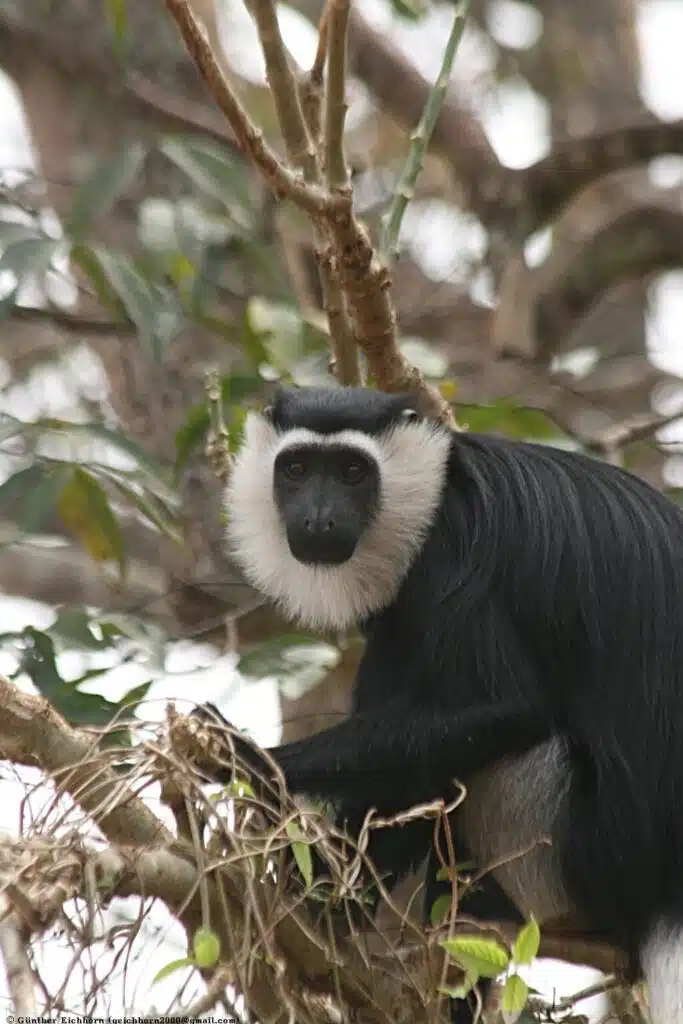
A species with a white mantle, White-Thighed Colobous (Colobus vellerosus) has white inner legs.
Additional white sections are found on its face while the top of its head is black. This is an arboreal species living in small groups.
Long white tails are also specific to these monkeys, typically with black tail tips.
While fragmented, its habitat is diverse as these monkeys can live in different forests.
From the rainforest to savannah forests, they can live in different areas with low predators and sufficient food.
White-thighed colobuses can live long lives here, sometimes up to 20 years.
They live and move on trees for food and shelter by grabbing branches.
Leaves are among the favorite foods of these monkeys because of their large fiber content. As fibrous foods, leaves take a long time to digest.
This also means these monkeys may become sluggish for hours soon after eating. They spend most of their lives sedentary.
12. White-throated Monkey
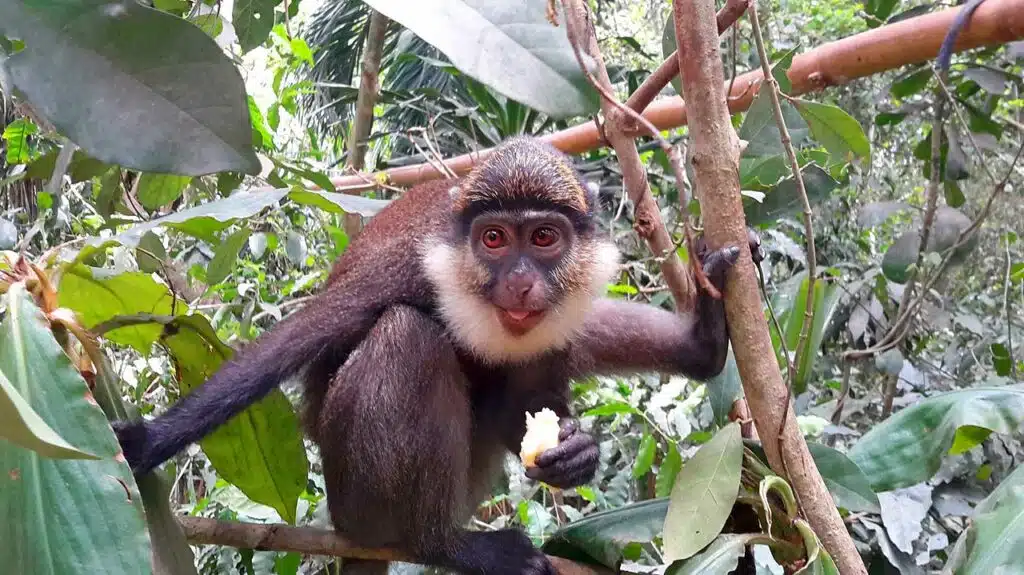
A rare rainforest species, White-Throated Monkeys (Cercopithecus erythrogaster) only survive in Nigeria and Benin.
These monkeys live close to water sources in the rainforest and survive in small populations in areas once believed to be fully extinct.
Mostly black, white-shroated monkeys have a white neck collar looking similar to a beard, a bright hairless mouth, and blue hairless face masks.
Fruit and insects are all part of its diet. It can forage for food and store any excess fruit in the cheeks.
These monkeys live in small groups where males breed with multiple females once mature. It takes at least 4 years for a White-Throated Monkey to mature.
These species are hunted locally for meat and they can soon become extinct in the wilderness.
13. Diana Guenon
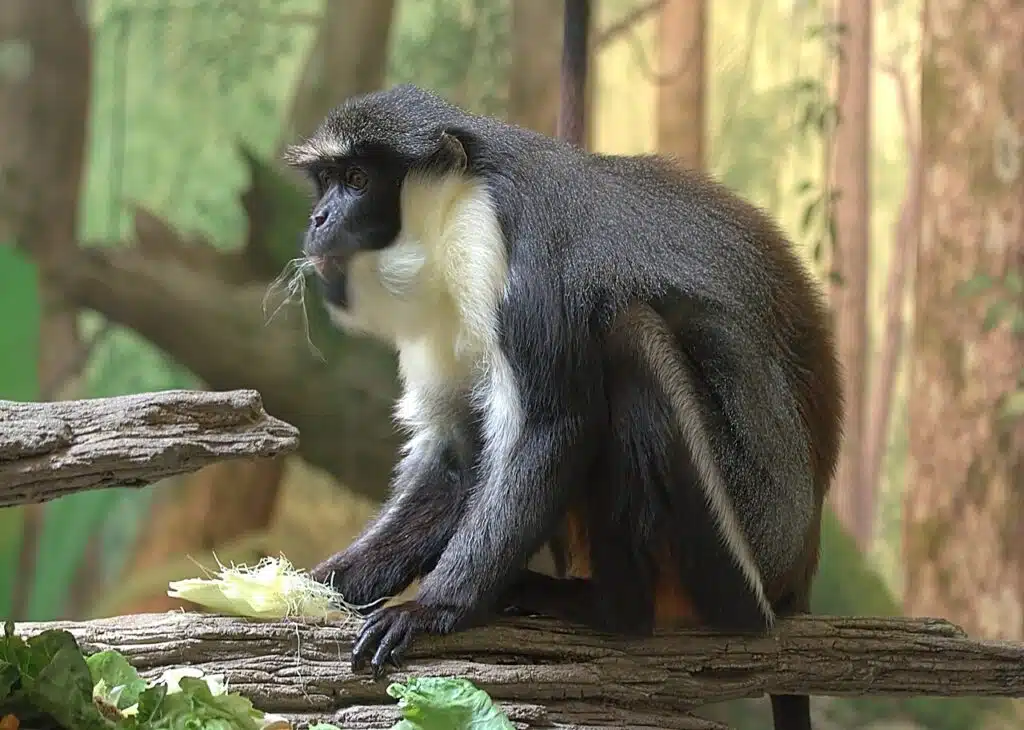
Mostly black, white, and brown, Diana Guenons (Cercopithecus diana) are natives of West African forests.
These monkeys are hunted locally but they can spread diseases to humans, some of which may have serious health consequences.
An arboreal species of Cote d’Ivoire and Liberia, Diana Guenons are mostly black and show white sections around the neck, on the chest, and on the upper front legs.
Also found in Ethiopia, these types of arboreal monkeys live in small groups where a single male breeds with multiple females.
One young is born, on average. Females provide food for the young until strong enough to venture out on their own.
While living in small groups, the importance of their hierarchy is inherited.
As a result, the young of an important female also becomes important in the hierarchy in a type of basic social hierarchy system.
14. Black-And-White Tassel-Ear Marmoset
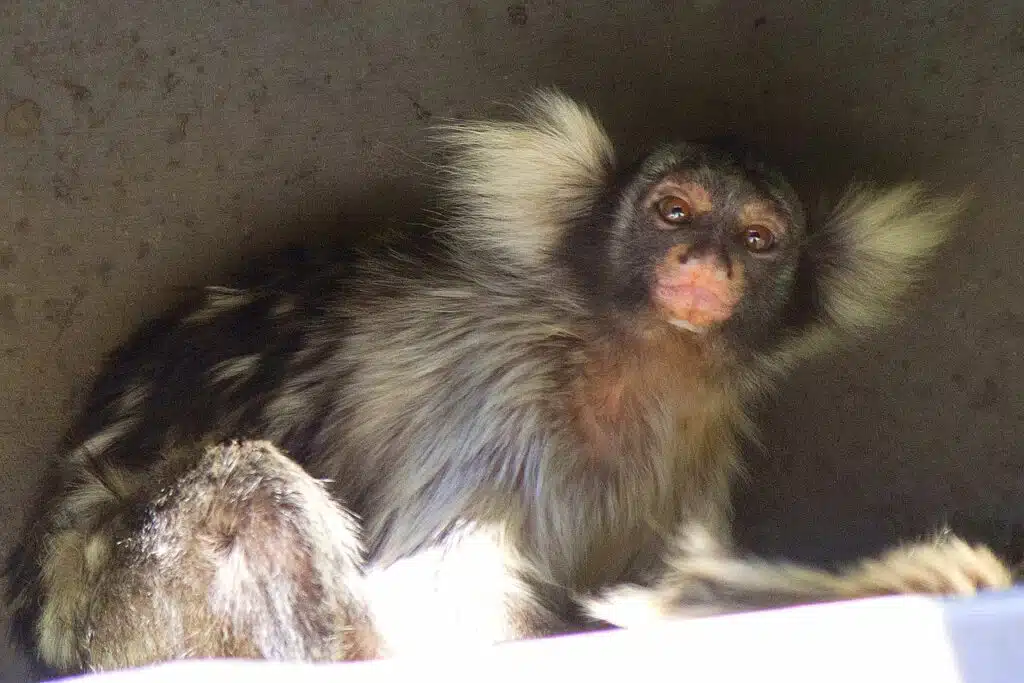
Mostly black with white hair tufts at the sides of the head, Black-And-White Tassel-Ear Marmosets (Mico humeralifer) are native to South America.
A species of The Amazon, these types of small monkeys live in dense and humid areas of the forest close to a freshwater source.
These types of monkeys mostly eat fruit, with seeds being a secondary choice but still an important source of nutrients as they get to disperse them through feces.
These types of monkeys reach maturity sooner than others. They’re ready to mate within 1-2 years.
Living in groups, Black-And-White Tassel-Ear Marmosets also share their maternal and paternal duties.
The young remains with the mother but both the father and the mother can provision and even carry the young.
In the absence of suitable foods, fathers can even resort to tree resins for nutrients to their young.
15. Black Snub-Nosed Monkey
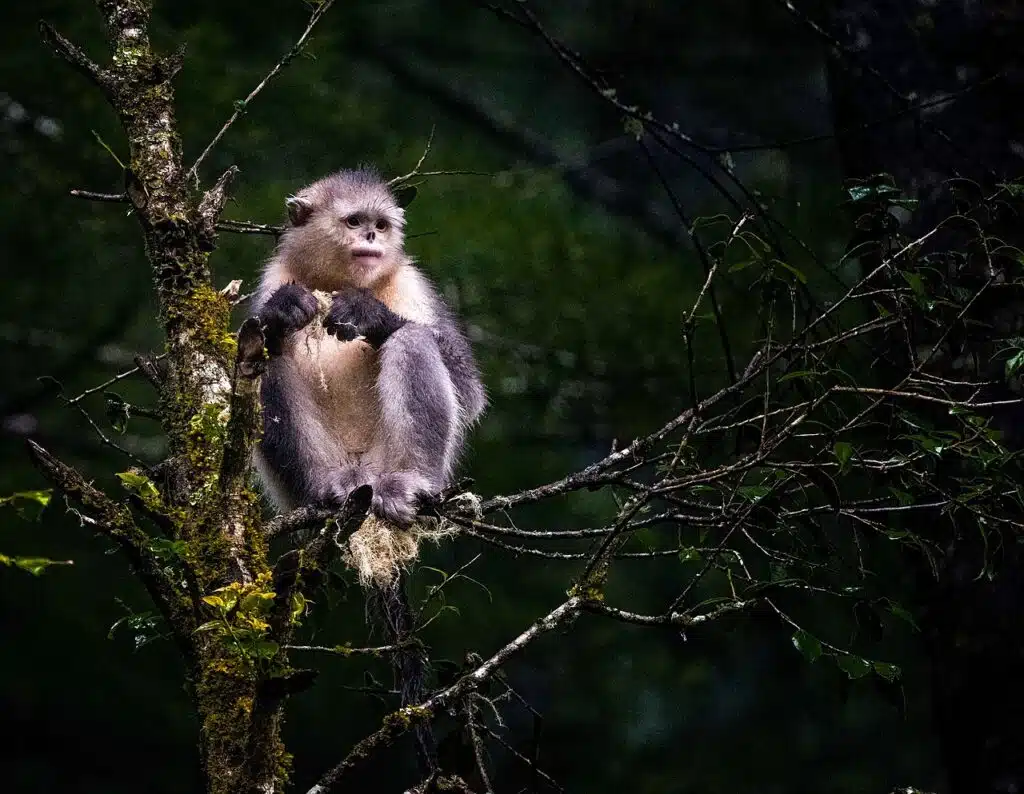
Mostly black and white, The Black Snub-Nosed Monkey (Rhinopithecus bieti) is endemic to China. This species is named after the shape of its nose which lacks a nasal bone.
It only lives in small Southern mountainous regions within The Yunnan area.
This is a monkey that even lives high up in coniferous forests as well as in forests as well as in forests at lower elevations.
Its diet is atypical for monkeys as well. Black Snub-Nosed Monkeys feed on lichens, for most days of the year.
Lichens cannot be eaten by most species due to their toxicity. Like other monkeys, Black Snub-Nosed Monkeys can digest toxic types of plants with specific enzymes.
This is a species that may also turn away from lichens whenever food sources are plentiful. Nectar is one of the sources it may turn towards in the absence of viable lichens.
While these monkeys can eat different foods, they are considered a threatened species mainly due to loss of habitat.
16. White-headed Lutung
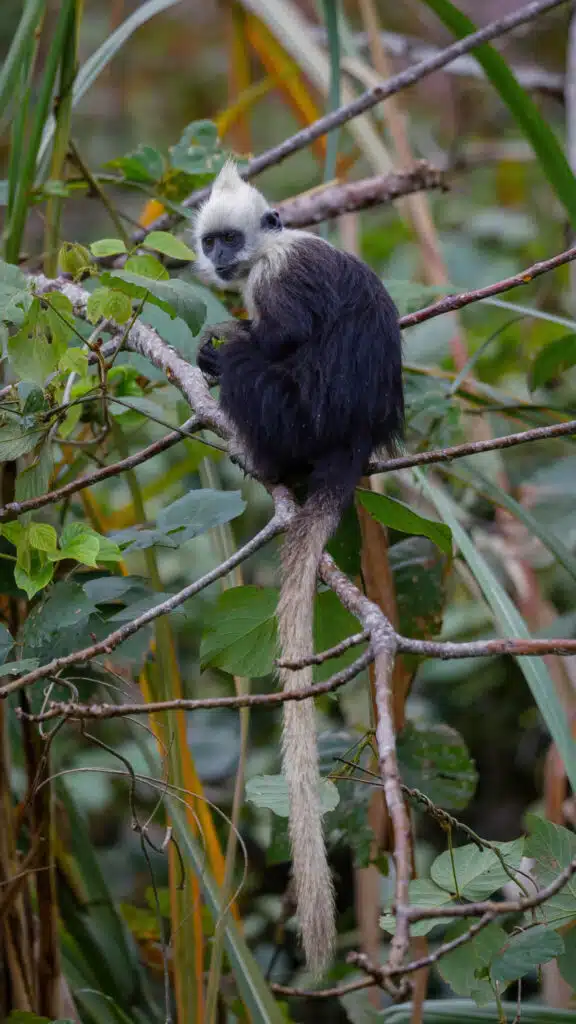
Mostly black, White-headed Lutungs (Trachypithecus leucocephalus) have white or yellow hairs on their heads.
These are some of the rarest types of monkeys, in general. They are even often categorized among the rarest types of primates in the world.
White-headed Lutungs live in a small and very specific habitat on Cát Bà Island in Vietnam.
It’s believed less than 70 White-Headed Lutungs once lived on the island before conservation efforts. While their number is small, it’s on a slight increasing curve over the past few years.
These rare monkeys live in small groups in some of the highest elevation points of the island, directly on limestone and on vegetation people cannot reach.
They forage here and also rely on their rocky territories for water consumption as the puddles created after it rains are the only freshwater source on the island.
This is a species that faces other uncertainties such as hunting as well as a low reproductive rate.
Once a wild habitat, this island is also slowly becoming industrialized and a threat to the habitat of the species also comes from an emerging tourism industry,
Today, more than 1,000 White-Headed Lutungs live here in a direct effort to protect the species.
Most of their diet is represented by local fibrous leaves.
17. King Colobus
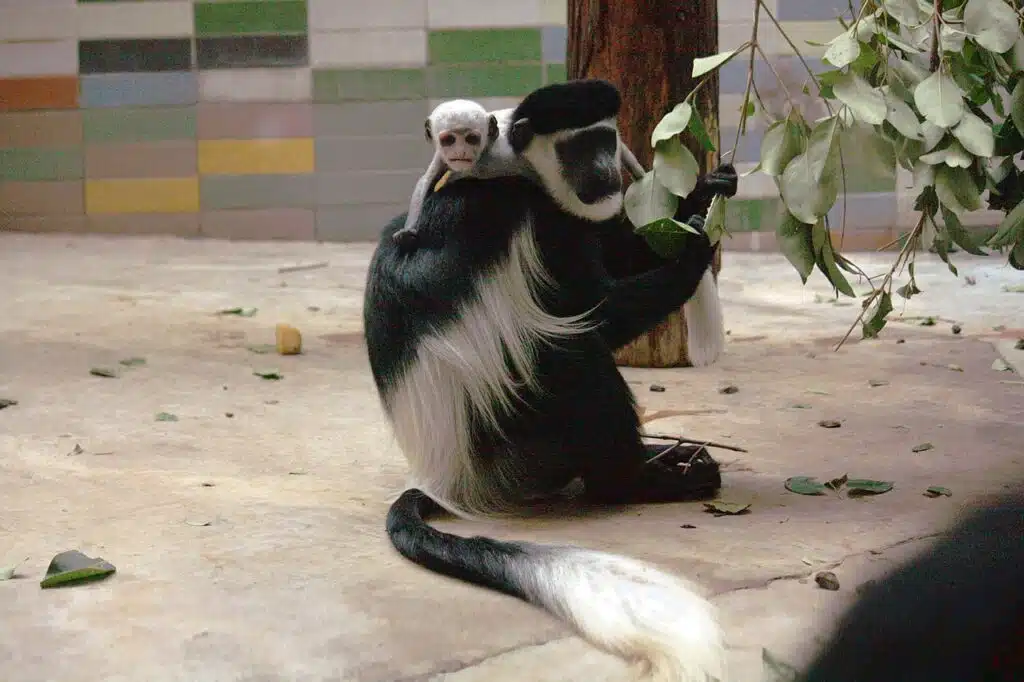
A black and white species with whitetails, King Colobus monkeys (Colobus polykomos) are monkeys of West Africa.
They live in forests of Liberia, Ivory Coast, and Senegal and are believed to be the monkeys that are found in the Westernmost point of Africa.
These types of monkeys are social and live in small groups.
These groups are dominated by females while the males have a breeding role.
Each group has multiple females and typically one or multiple males. Females communicate between them while males show aggression and dominance over other males.
This aggression is also shown in their vocalizations as roars are used by males to keep other males at a safe distance.
Males can also communicate the presence of potential predators in the area through specific vocalizations.
This is why a male breeds with multiple females within the group.
Feeding on leaves, the species is often found among a diminishing habitat of leguminous trees in the bean family.
The dry season also marks diet changes, as in other monkeys. King Colobus monkeys feed on fruit, alternatively.
Once they reach adulthood, they measure anywhere between 22 and 26 inches.
18. Cotton-Headed Tamarin
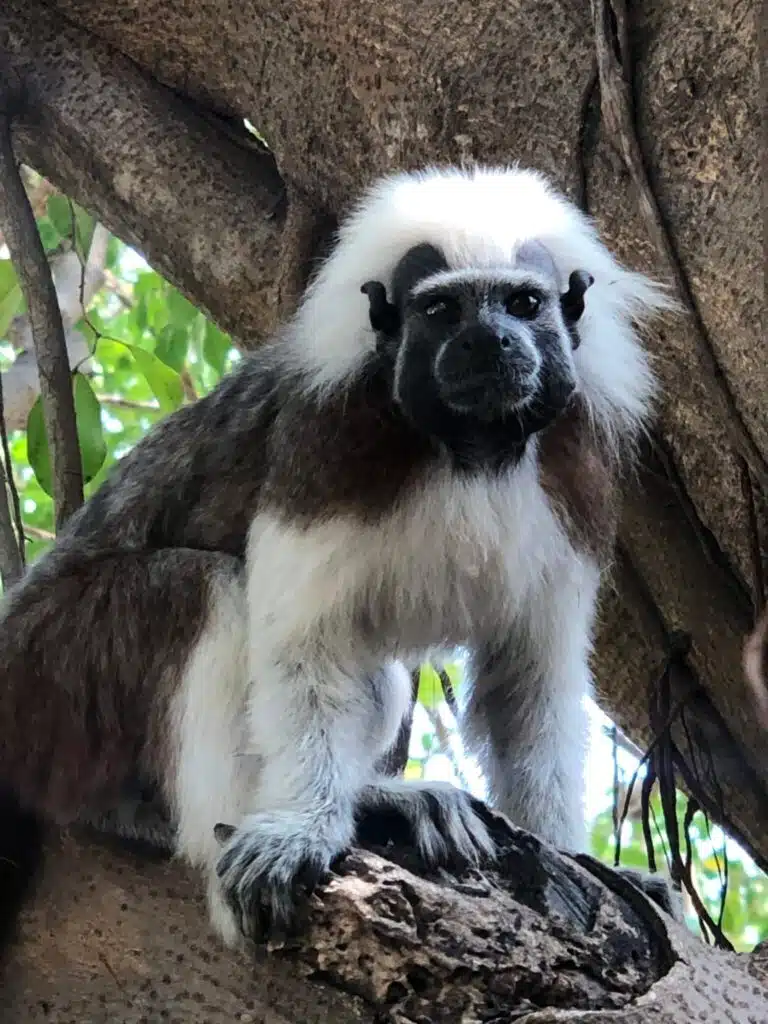
Endemic to Colombia, Cotton-Headed Tamarins (Saguinus oedipus) are some of the smallest monkeys and even primates in the world.
This is a species that may even grow to 8 inches as an adult.
Black and white, the monkey features additional long hairs from its forehead to the back of the neck in a distinctive physical trait.
Cotton-Headed Monkeys live in forests, preferably at low elevations. Populations of up to a few thousand are specific to this species.
Social hierarchies are specific to these groups of monkeys where a male and a female are dominant.
The dominant male and female get to breed while other females can’t breed. This is achieved through pheromones.
Collaboration is specific among the groups. For example, females work together to care for the offspring or the dominant female.
While small, these monkeys are also very smart when it comes to communication. They have different vocalizations for the types of activities they undergo.
There’s a vocalization that confirms their liking of a food, as an example.
19. Preuss’s Monkey
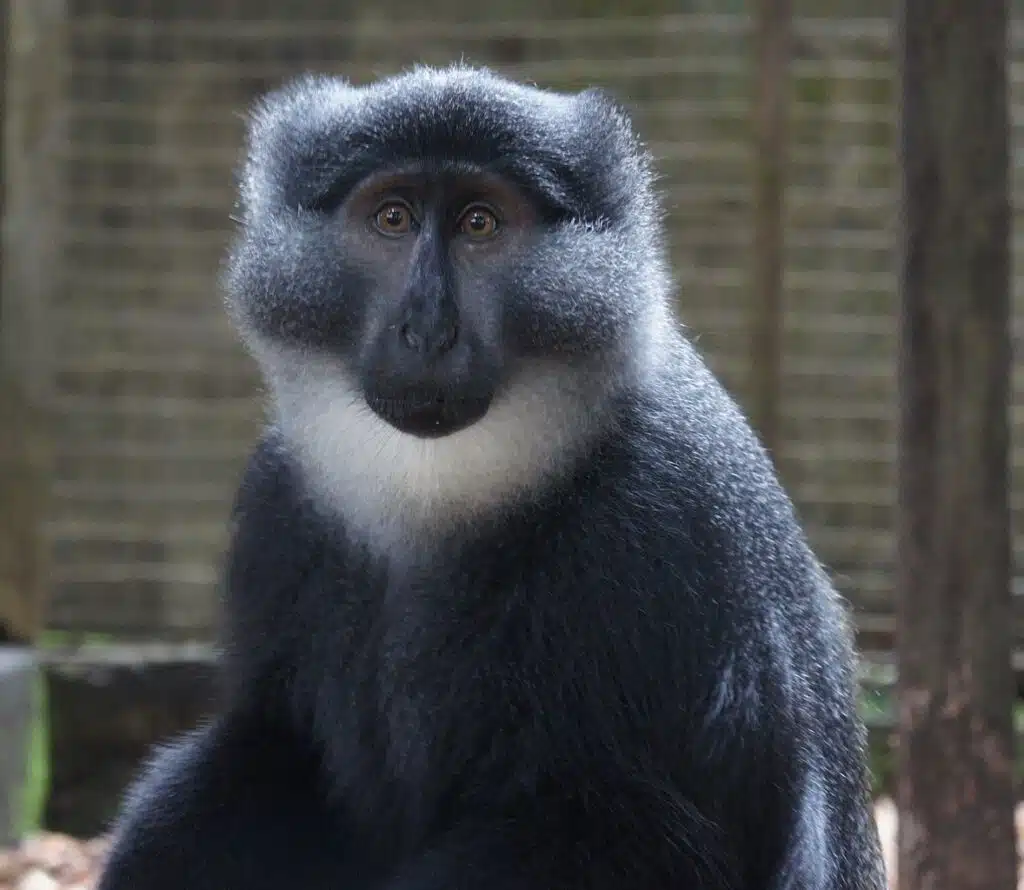
Mostly black, Preuss’s Monkeys (Allochrocebus preussi) feature white necks and scarce white hairs on their blackheads.
Found at the border of Nigeria and Cameroon, Preuss’s Monkeys are a rare sight.
The scarcity of these monkeys in inhabited areas is dependent on their remote living.
They live at altitudes of several thousand feet, which means they’re a rare sight even if they live long. Preuss’s Monkeys can live up to 3 decades.
Not much is known about their social life apart from them living in groups with a male, females, and offspring which are born every few years.
The groups of these monkeys can be larger than of others, with up to 12 individuals per group, including the young.
Monkeys of this genus have different vocalizations but are believed to be quieter than other species.
Apart from the vocalizations, these monkeys also communicate with them with facial expressions.
20. Bornean Grey Langur
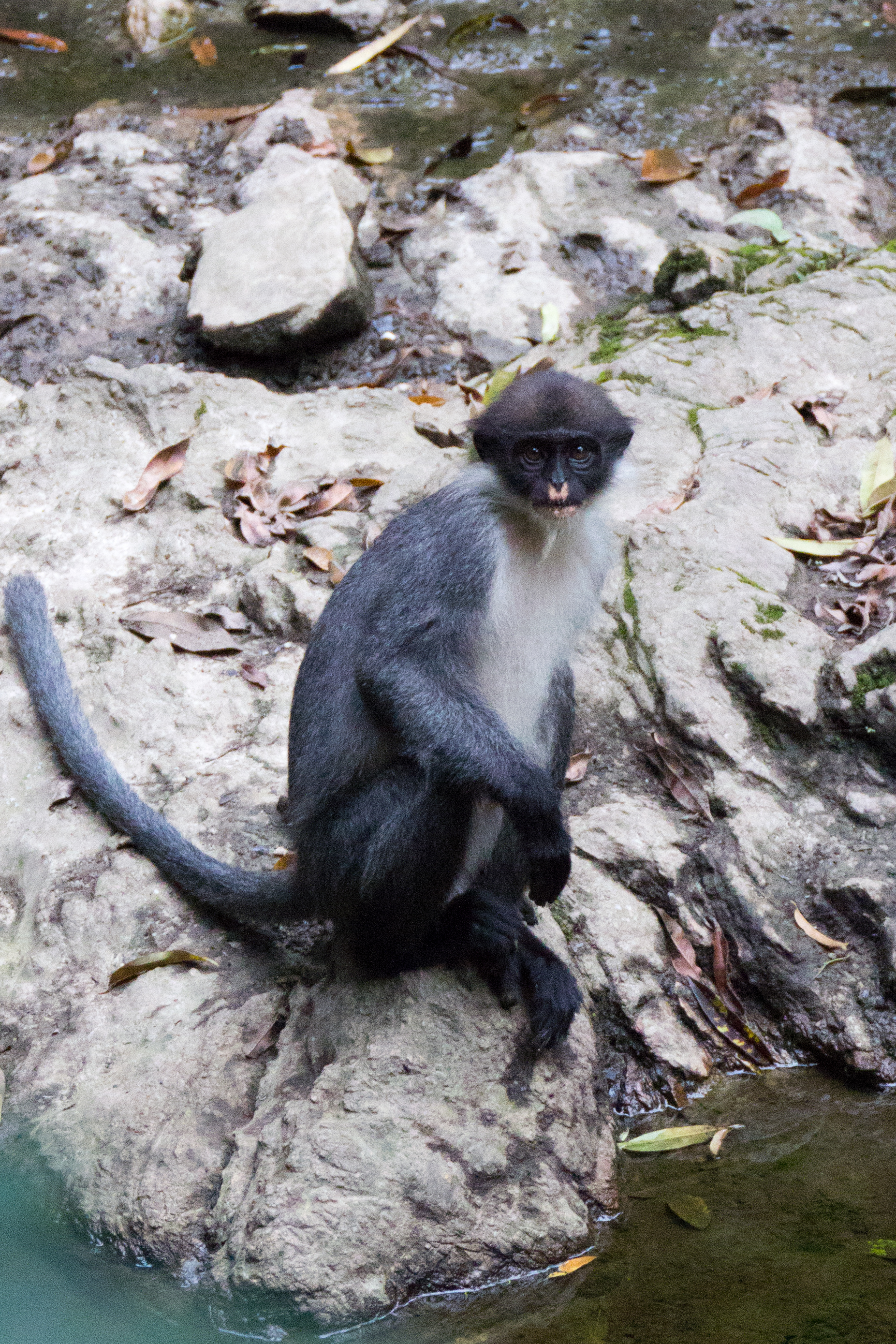
A Borneo native, The Bornean Grey Langur (Presbytis hosei) has black and white coloring.
A black mask contrasts its white and black head while its neck has a white collar similar to a beard.
While opportunistic feeders, Bornean Grey Langurs have a diet based on leaves.
They can eat even the thickest leaves as they can break them down with enzymes. Bornean Grey Langurs eat a large number of leaves per day but they can also consider other foods.
These black, white, and gray monkeys also eat fruit and eggs. Monkeys of this genus also have atypical food choices such as mud rich in minerals.
Living in small groups, these monkeys use vocalizations to alert other groups of their surroundings which they guard with vivacity.
Males can enter fights with the males of other groups, in case of trespassing.
A species that can survive up to 25 years, these monkeys also show a tendency not to adapt to changes in the habitat which makes them endangered.
21. De Brazza’s Monkey
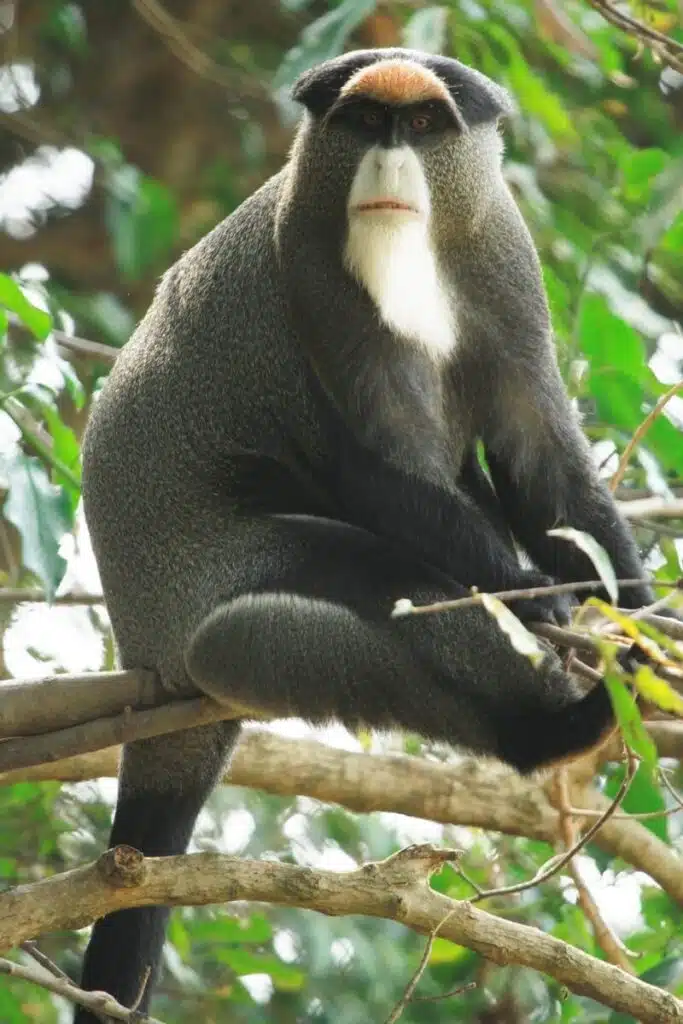
De Brazza’s Monkeys (Cercopithecus neglectus) are gray, brown, red-brown, white, and black. These colorful monkeys are mostly known for their white beards which make them easy to identify.
Living in Central and Western African forests, the monkeys show a tendency to live in groups, depending on their region.
While rare, males and females can live in separate groups with their offspring. This typically happens after the monkeys reach the age of 5, the point of sexual maturity.
They also live in female-dominate groups with a single male which breeds with all females.
Most of their diet is based on the plants they find on the ground in the natural habitat of their humid forests.
Fruit and bugs are also solid options when found in the forest.
These monkeys are known to hide when seeing humans or predators. Some of their first lines of defense are to seek shelter and wait for predators to move along.
Hawks are some of their typical predators.
Their habitat is packed with potential predators.
Living in swamps or close to rivers or streams in the forest, these monkeys treat all other species with fear or aggression, depending on whether they can engage them in a fight or not.